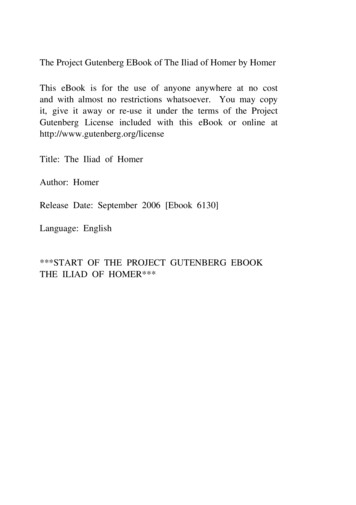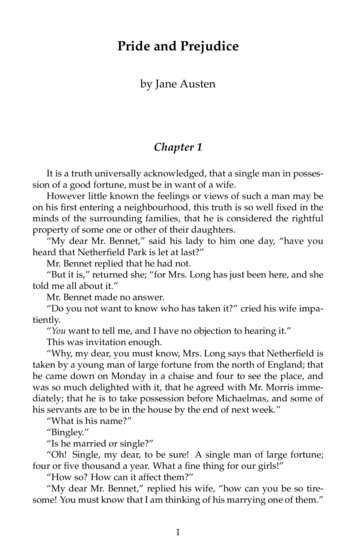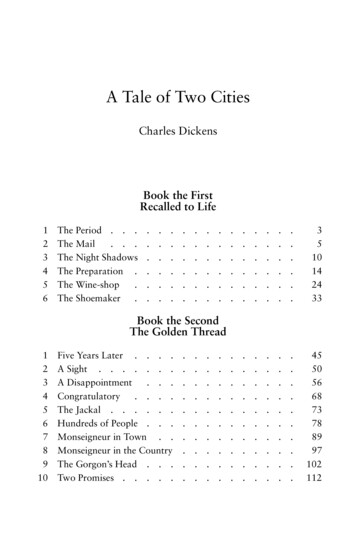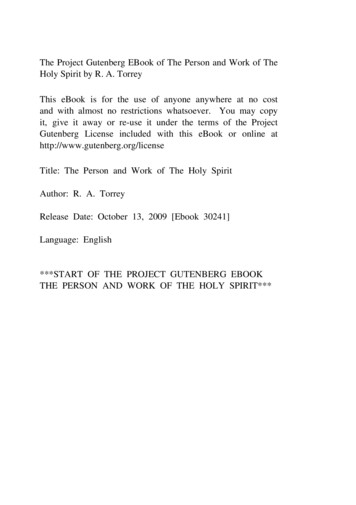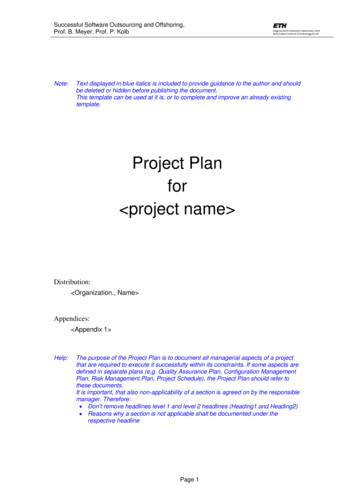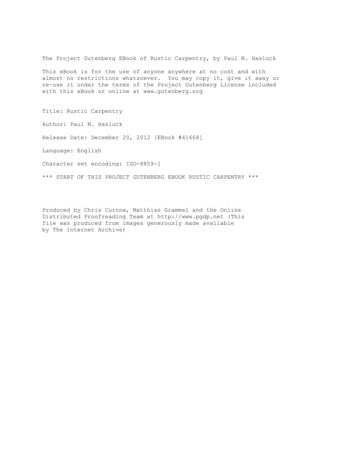
Transcription
The Project Gutenberg EBook of Rustic Carpentry, by Paul N. HasluckThis eBook is for the use of anyone anywhere at no cost and withalmost no restrictions whatsoever. You may copy it, give it away orre-use it under the terms of the Project Gutenberg License includedwith this eBook or online at www.gutenberg.orgTitle: Rustic CarpentryAuthor: Paul N. HasluckRelease Date: December 20, 2012 [EBook #41668]Language: EnglishCharacter set encoding: ISO-8859-1*** START OF THIS PROJECT GUTENBERG EBOOK RUSTIC CARPENTRY ***Produced by Chris Curnow, Matthias Grammel and the OnlineDistributed Proofreading Team at http://www.pgdp.net (Thisfile was produced from images generously made availableby The Internet Archive)
[Pg 2][Pg 3]
RUSTIC CARPENTRYWITH NUMEROUS ENGRAVINGS AND DIAGRAMSEDITED BYPAUL N. HASLUCKEDITOR OF "WORK" AND "BUILDING WORLD"AUTHOR OF "HANDYBOOKS FOR HANDICRAFTS," ETC. ETC.CASSELL AND COMPANY, LIMITEDLONDON, PARIS, NEW YORK & MELBOURNE. MCMVIIALL RIGHTS RESERVED[Pg 4][Pg 5]PREFACE.This Handbook contains, in a form convenient for everyday use, a number of articles on RusticCarpentry contributed by various authors to WORK—one of the journals it is my fortune to edit.Readers who may desire additional information respecting special details of the matters dealt within this Handbook, or instructions on kindred subjects, should address a question to the Editor ofWORK, La Belle Sauvage, London, EC., so that it may be answered in the columns of that journal.P. N. HASLUCK.La Belle Sauvage, London.April, 1907.[Pg 6]CONTENTS.
CHAPTERI. — Light Rustic WorkII. — Flower Stands, Vases, �————————TablesChairs and SeatsGates and FencesRosery WalkPorchesCanopy for SwingAviaryFoot-bridgesVerandahsTool Houses, Garden Shelters, etc.Summer HousesIndexPAGE922364052667177839298106126159[Pg 7]LIST OF ILLUSTRATIONS.FIG.1. — Photograph Frame and Wall Bracket Combined2. — Section of Bracket3. — Small Easel4. — Attaching Support to Easel5. — Mitred Joint6. — Mortise and Tenon Joint7, 8. — Flower Holder9-11. — Rustic Hall Stand12, 13. — Plant Stool14-16. — Window Box17. — Flower-pot Stand18. — Bending Saplings19. — Fixing Rails, etc., to Posts20. — Vase on Tripod Stand21. — Joint of Hexagon Sides of VasePAGE10111213131414, 15171819, 202324242525
22. — Securing Sides and Legs of Vase to Base23. — Section of Twigs at Angles of Vase24, 25. — Flower-pot Stan26. — Joining Rails to Uprights27. — Supporting End Shelves of Flower-pot Stand28. — Fixing Centre Shelves of Stand29. — Large Square Vase30. — Large Hexagonal Vase31. — Vase with Claw Foot32. — Foot of Rustic Table33. — Garden Plant Tub34, 35. — Mouldings36. — Plant Vase37. — Rectangular Garden Plant Stand38-40. — Rustic Pedestal41. — Flower-pot Stand42. — Square Table43. — Hexagon Table44, 45. — Top of Hexagon Table46. — Armchair47. — Fixing Seat Rails to Leg of Armchair48. — Plan of Armchair Seat Frame49, 50. — Garden Seat51. — Joints of Rails and Posts52. — Arm-rest for Garden Seat53. — Part Plan of Seat54, 55. — Garden Seat56. — Front Rail, Cross Rail, and Battens57. — Part Plan of Seat58-60. — Garden Seat with Canopy61. — Plan of Canopy62, 63. — Canopy Panels64. — Plan of Seat65-67. — Garden Gate68-70. — Joints in Gate Frame71, 72. — Fixing Ends of Twigs73. — Closing Stile74-77. — Joints in Gate Frame78-80. — Fences81, 82. — Rustic Trellis with Seats and Gate83. — Vertical Section of Trellis25252627272728282930313232333435363738, 3940414142, 4343444444, 45454647-4950505052, 5354545455, 5657, 585960
84. — End Post and Trellis6085. — Back of Seat for Trellis6086. — Alternative Design for Gate6187. — Hanging and Latching Gate6288. — Catch for Gate6389, 90. — Rustic Carriage Entrance64, 6591. — Rosery Walk6792. — Roof of Rosery Walk6893. — Entrance to Rosery Walk6994, 95. — Porch72, 7396. — Seat and Floor of Cottage Porch7497. — Porch at Gable7498. — Porch at Eaves7599. — Roof for Porch75100. — Gable for Porch76101, 102. — Rustic Canopy for Swing77, 78103. — Fixing Middle Post of Canopy to Sill79104. — Joints of Rails, Struts, and Posts for Canopy79105. — Securing Cross Rails to Plates and Posts of Canopy80106, 107. — Hook and Thimble for Canopy80[Pg 8]FIG.108, 109. — Fenced Seat for Canopy110. — Fixing Rope to Eyelet111, 112. — Aviary113, 114. — Joint of Rails and Uprights for Aviary115. — Sectional Plan of Aviary116. — Cross Section of Aviary117. — Half Under View of Bottom of Aviary118. — Door Wires for Aviary119. — Part Longitudinal Section of Aviary120. — Half Plan of Aviary Roof121, 122. — Rustic Foot-bridge123. — Girders for Foot-bridge124, 125. — Joint of Post and Girder126. — Middle Rail and Post of Foot-bridgePAGE818184, 858586878888899092, 93939394
127, 128. — Joint of Strut to Post of Foot-bridge94129. — Twig Hollowed to Fit Rail94130. — Elevated Bridge95131. — Girder and Post bolted to Sleeper96132. — Elevated Foot-bridge at Lower Step (Fig. 130)96133, 134. — Verandah99, 101135. — Bottom of Post for Glazed Verandah103136. — Top of Post for Glazed Verandah103137, 138. — Rustic Tool House106, 107139. — Common Method of Using Slabs108140. — Ground Plan of Rustic Tool House109141. — Cap of Tool House Pilaster111142. — Garden Snuggery112143. — Ground Framework of Garden Snuggery113144. — Back Framework for Garden Snuggery113145. — Snuggery Porch114146. — Window-board115147, 148. — Sections of Snuggery Walls117149-151. — Garden Retreat118-121152. — Seat of Garden Retreat122153. — Joint of Garden Retreat at C (Fig. 151)123154. — Detail of Front Joints (see C, Fig. 151)124155. — Alternative Method of Joining Rails to Posts124156. — Section of Middle Rail at A (Fig. 152)125157. — Detail of Middle Rail at B (Fig. 152)125158-161. — Lean-to Summer House126-131162-164. — Shelter for Tennis Lawn133, 134165. — Connecting Plates to Corner Post135166. — Fixing Sleeper to Posts135167. — Section of Flooring135168. — Finial135169. — Garden Shelter at Front Eaves135170. — Section of Seat135171. — Strapping Cushion to Seat137172-174. — Octagonal Summer House137, 139175. — Collar Posts and Ends of Wall Plates141176. — Timbers over Entrance of Octagonal Summer House141177. — Window Side of Octagonal Summer House143178, 179. — Table for Octagonal Summer House145180. — Seat Side of Octagonal Summer House147181. — Mosaic Seats149
182-184. — Octagonal Summer House with Three Gables185, 186. — Roof for Octagonal Summer House187. — Securing Glass to Rustic Casement188, 189. — Door for Octagonal Summer House190. — Part Plan of Octagonal Summer House191. — Horizontal Section through Door Posts192. — Part Section of Side Panel193. — Fixing Plate to Posts194. — Finial151-153153154155156156157157157[Pg 9]RUSTIC CARPENTRY.CHAPTER I.LIGHT RUSTIC WORK.Rustic carpentry does not demand great skill in woodworking, but it does require a large amountof artistic perception. The tools needed are but few, and the materials employed are comparativelycheap, although in many districts they are becoming dearer every year.It may be said that any articles made from the now popular bamboo may be made quite aseffectively in light rustic work.For light rustic work, sticks of hazel, cherry, yew, blackthorn, birch, larch, fir, and the prunings ofmany varieties of shrubs may be used; but it is necessary that the material should be cut at theproper season, and thoroughly dried before being worked up. The sticks should be cut in midwinter, as at that time the sap is at rest; if cut in the summer time the bark will peel off. If peeledsticks are required, they should be cut in the spring, when the sap is rising, as at that time the rindwill come off easily. In some districts the copses are cleared of undergrowth periodically, and thesticks (generally hazel) sold to hurdle and spar makers. A selection of these sticks would be verysuitable for the purpose here described.[Pg 10]The sticks should be stacked in an open shed in an upright position if possible, and in such amanner that the air can freely circulate around them. When they are required for fishing rods orwalking sticks they are hung up to season—this keeps them straighter; but the hanging of them up
is not necessary for the work about to be dealt with. When the sticks have been put away for fromsix to twelve months, according to size, they will be ready for use, after being rubbed with a clothor brushed to clean off the dust and bring up the colour of the bark. Fir cones may often be workedinto a design, and bits of rough bark and the warts and burrs found on old elm trees may becollected by the rustic worker and put by for future use.Fig. 1.—Photograph Frame and WallBracket Combined.One method of treatment for designs in light rustic work is to split the sticks and use them tooverlay the work with a Swiss pattern, as [Pg 11] shown by Fig. 1; another method is to work thesticks up after the manner that canes are used in bamboo furniture (see Figs. 3 and Fig. 42, pp. 12and 36).
Fig. 2.—Section of Bracket, showingFixing of Glass.Fig. 1 represents a wall bracket with a photograph or mirror in the frame. To make this, the pieceforming the back is first cut out of 3/8-in. deal. The shelf, of ¾-in. deal, is then nailed to the bottomedge. Some straight hazel, fir, or other sticks are next selected and split; these are nailed round theedges of the back, and round the opening at the centre. The pieces round the opening overlap theedges about ¼ in., to form a rebate for the glass. The bare spaces at the sides and top may becovered in the following manner: Take a piece of brown elm bark and run a saw into it. Catch thesawdust, and, after warming the wood, cover it with thin glue.[Pg 12]
Fig. 3.—Small Easel in Rustic Work.Sprinkle the brown sawdust on the glued surface, and sufficient will adhere to cover the deal andgive the frame a rustic appearance. Cork-dust or filings may be used instead of sawdust. Bunchesof fir or larch cones are nailed to the corners, as illustrated; these should be pared at the back withknife or chisel to a flat surface. The outer edge of the shelf is finished with an edging of short [Pg13] lengths of split stick nailed on. The general construction of the bracket, and the method offixing the glass, will be clear from Fig. 2, which is a section through the centre.
Fig. 4.—Method of Attaching Support to Easel.Fig.5—Mitred Joint.A small easel for photographs, or, if constructed larger, for a fire-screen, is shown by Fig. 3. It ismade entirely of round sticks. Fig. 4 illustrates the method of attaching the back support—namely,by means of a couple of staples, which may be made out of a hairpin. In jointing round stickstogether, the joints may be mitred by notching a V-shaped piece out of one stick and cutting theother to fit (Fig. 5); or a mortise and tenon, as represented by Fig. 6, may be used.In making the easel (Fig. 3), the top and bottom bars are mitred to the sides, and the central uprightto the top and bottom bars. The joints are secured by either brads or panel pins. Care must be takento bore for the nails with a bradawl, as nothing looks worse than splits in the work. The uprightpiece in the centre of the top bar may be secured by driving a long panel pin into the lower uprightthrough the top bar, filing the head to a point to form a dowel, and driving the top piece on with ahammer.[Pg 14]
Fig. 6.—Mortise and Tenon Joint.
Fig. 7.—Rustic Flower Holder for Table Decoration.Where a small stick is joined to a larger one, as in the case of the filling-in pieces, a flat may bemade with a knife or chisel on the larger stick, and the smaller one cut to fit and nailed on. Inmaking a small easel, only a single stick attached to the [Pg 15] centre upright will be required toform a back support, but for a larger one it will be preferable to frame it as shown by Fig. 3.
Fig. 8.—Rustic Flower Holder Complete, with Cocoanut Vase in Position.The finished articles may be either stained and varnished or left plain. Cherry sticks look well ifthe bark is left the natural colour, and the ends, where exposed, cleaned off and varnished withoutbeing stained. Some sticks improve in colour if rubbed over with a rag moistened with linseed oil.If a stain is required, one that is sold in bottles would be suitable, but a little vandyke brown,ground in water, and applied with a sponge, answers the purpose. Sometimes, as in the case of thetable top (see Fig. 42, p. 36), it is [Pg 16] a good plan to stain the wood before nailing on the patternwork, or there will be danger, if the sticks are dark in colour, of the lighter wood showing through.
If the rustic work is intended to be placed out of doors, it should be given two or three coats ofhard outside varnish.The rustic flower-holder for table decoration, shown by Fig. 7, consists simply of a gipsy tripodformed with six rustic sticks, put together in the form shown, and tied with a length of bass. Thereis no attempt made at finish, but the sticks must be firmly tied together at the joints, and the endsof the bass can be left, either hanging loose or tied in a bow. The holder for the flowers is acocoanut shell, which has been sawn in two, so as to leave one part a sort of cup or egg shape;three holes are bored with a bradawl at equal distances round the edge, and it is suspended fromthe tripod with three more pieces of the bass, which completes the arrangement. Of course, anysmall receptacle can be used in place of the cocoanut shell, but that, perhaps, carries out the rusticappearance the best, and is very easily obtained. Fig. 8 is an attempt to show the tripod whendecorated.The rustic hall-stand shown by Figs. 9 to 11 was made actually from branches and twigs of an oldapple tree. The uprights and principal cross-pieces are 7/8 in. thick, and the criss-cross pieces are½ in. thick. The bottom is made of four pieces 1½ in. thick. The longer ones measure 1 ft. 8 in.,and the shorter ones 1 ft. 2 in.; they are nailed together in such a manner that the
The Project Gutenberg EBook of Rustic Carpentry, by Paul N. Hasluck This eBook is for the use of anyone anywhere at no cost and with almost no restrictions whatsoever. You may copy it, give it away or re-use it under the terms of the Project Gutenberg License included with this eBook or online at www.gutenberg.org Title: Rustic Carpentry Author: Paul N. Hasluck Release Date: December 20, 2012 .
